Reserve Bank of Australia Annual Report – 2016 Operations in Financial Markets
The Reserve Bank transacts in domestic and international financial markets in order to meet the Bank's policy objectives. These transactions include implementing the monetary policy decisions of the Reserve Bank Board, facilitating the smooth functioning of the payments system, managing the nation's foreign reserve assets and providing banking services to clients (mainly the Australian Government and its agencies and foreign central banks).
Balance Sheet
The Reserve Bank's balance sheet was around $167 billion as at 30 June 2016, an increase of around $10 billion over the financial year. On the liabilities side, the increase mainly reflected a $5 billion increase in issuance of banknotes. The increase in liabilities was accommodated on the assets side of the balance sheet by an increase in net foreign exchange reserves, primarily owing to valuation effects from the depreciation of the Australian dollar.


Domestic Market Operations
Management of system liquidity
The Reserve Bank Board's operational target for monetary policy is the cash rate – the rate at which banks borrow and lend to each other on an overnight, unsecured basis. The Board adjusted the cash rate target once during 2015/16, from 2 per cent to 1.75 per cent in May 2016. The cash rate was reduced by a further 25 basis points to 1.5 per cent in August 2016. During 2015/16, the cash rate was equal to the Board's target on all days.
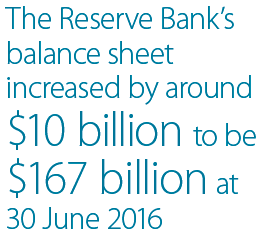
To implement the cash rate target, the Reserve Bank operates in financial markets each day to maintain an appropriate level of Exchange Settlement (ES) balances. These balances are used by around 90 financial institutions to settle their payment obligations – including transactions undertaken between each other on an overnight, unsecured basis – and are liabilities of the central bank. The level of ES balances is altered by transactions between customers of the Reserve Bank (principally the Australian Government) and ES Account (ESA) holders (mainly financial institutions). Separately, the Reserve Bank is able to affect the level of ES balances by buying or selling government securities on an outright basis, undertaking transactions in the repurchase agreement (repo) market or using foreign exchange swaps against the Australian dollar. These transactions are undertaken with a view to ensuring that the demand for ES balances is equal to the supply of ES balances at the cash rate target.
Most of the Reserve Bank's transactions occur as part of its main round of open market operations. The Bank publishes its dealing intentions for these operations each business day at 9.30 am. The dealing intentions typically include the total amount of the operation and the Bank's preferred terms for transacting repos. These terms are generally chosen with a view to smoothing the effect on ES balances of expected future transactions between clients of the Bank, such as the Australian Government, and ESA holders. The terms dealt in 2015/16 had an average of 40 days, with a maximum of 172 days. Entities wishing to participate in open market operations have a 15-minute window in which to submit their approaches for the auction that determines the liquidity injection. The results of the main round of open market operations are announced shortly after 9.45 am.
To ensure that unforeseen payments during the day do not adversely affect the implementation of monetary policy, the Reserve Bank has the option of undertaking additional rounds of market operations late in the afternoon. Every business day at 5.10 pm, the Bank announces its intention to deal (or not to deal) for a second time that day. Such additional dealing rounds averaged four per month during the past financial year, with around two-thirds of these operations intended to drain liquidity. In the event of unforeseen liquidity developments later than this, further additional rounds can be announced if the need arises, though no such operations were required in 2015/16.
Total ES balances in 2015/16 were typically around $24 billion. Around $22 billion of this was required to be maintained as contracted open repo positions to meet liquidity needs arising from payment obligations outside normal banking hours. These are remunerated at the cash rate target. In addition to these balances, ESA holders typically hold aggregate surplus balances of around $2 billion. As these surplus balances are remunerated at a level that is 25 basis points below the cash rate target, institutions operating ESAs typically aim to maintain their accounts with a small positive balance. Where an ESA holder faces a shortage in ES balances and funds cannot be borrowed from another financial institution, the Reserve Bank is willing to advance funds overnight against eligible securities at an interest rate 25 basis points above the cash rate target. This corridor system is designed to incentivise account holders to actively manage their liquidity position around the midpoint, which is the target cash rate. During 2015/16, ESA holders accessed overnight funding from the Bank on only one occasion.
Over the past couple of years, the level of surplus ES balances has increased from around $1 billion to around $2 billion, with large variations in daily balances. The increase has partly reflected an increase in demand from banks to hold ES balances to comply with the Liquidity Coverage Ratio (LCR), which was introduced in 2015 as part of the Basel III liquidity framework – balances held at a central bank by financial institutions are deemed to be high-quality liquid assets (HQLA). This demand has been quite variable, as has been the seasonal demand for surplus liquidity around the end of each calendar quarter. This variability in the demand for ES balances requires the Reserve Bank to adjust the quantity of ES balances it supplies in open market operations. The amount of ES balances provided by the Bank ensured that sufficient funds were available in the cash market for all institutions to meet their payment obligations and the cash market cleared at the Board's target on all days in 2015/16.

| Number of occasions funding sought | Average value of funding provided $ million |
|
|---|---|---|
| 2009/10 | 5 | 207 |
| 2010/11 | 2 | 182 |
| 2011/12 | 5 | 221 |
| 2012/13 | 2 | 94 |
| 2013/14 | 6 | 226 |
| 2014/15 | 3 | 142 |
| 2015/16 | 1 | 115 |
|
(a) Includes overnight repos and ESA balance shortfalls relative to open RBA repo positions Source: RBA |
||
Administration of the cash rate
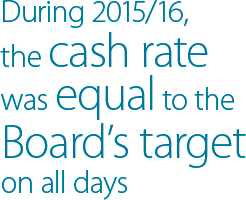
The Reserve Bank is the administrator of the cash rate, which is the operational target for monetary policy. The cash rate is also a significant financial benchmark referenced in overnight indexed swaps and the ASX's 30-day interbank futures contract. Prior to May 2016, the Bank received submissions each day from ESA holders on their gross unsecured borrowing and lending in the overnight interbank market. From May 2016, the Bank has calculated the cash rate directly from market transactions, sourcing individual transaction data directly from the Reserve Bank Information and Transfer System (RITS). The new process involves the Bank accessing a considerably more detailed dataset, which includes the individual amounts and interest rates at which ESA holders transact in the cash market (back-testing verified that the two methodologies delivered the same outcome). Calculating the cash rate from individual transaction data makes the benchmark more robust and reduces the compliance burden for banks, since they no longer need to make submissions. Using the additional data available, the Bank has also commenced publishing the number of cash market transactions. From May 2016, there were around 30 cash market transactions each day, with aggregate daily activity in the cash market in 2015/16 averaging around $4.5 billion.
The Reserve Bank implemented the new cash rate methodology to better align its processes with the best practice standards set out by the International Organization of Securities Commissions (IOSCO) in its report on Principles for Financial Benchmarks (the IOSCO Principles).[1] The Bank published the Cash Rate Procedures Manual, which sets out in more detail the Bank's governance arrangements for administering the cash rate and the procedures for handling errors and complaints.[2] The Bank also published a self-assessment of the compliance of the new methodology with the IOSCO Principles.[3]
In conjunction with these changes, the Reserve Bank also commenced publishing a Cash Rate Total Return Index (TRI). The TRI measures the performance of an investment earning the cash rate and can be used by members of the public as a risk-free reference rate. This initiative followed consultation with market participants, and is consistent with a recommendation by the Financial Stability Board for the development of risk-free interest rate benchmarks, which are more a reflection of bank funding costs, as alternatives to existing benchmarks.[4]
Committed Liquidity Facility
Banks subject to the LCR under the Basel III liquidity standard are required to hold sufficient HQLA to meet outflows during a 30-day period of stress. Given the relatively low levels of government debt in Australia there is a shortage of HQLA securities, which are Australian Government Securities (AGS) and semi-government securities (semis). To address this, the Reserve Bank provides the Committed Liquidity Facility (CLF), which is a contractual commitment to funding under repo with the Reserve Bank, subject to certain conditions. These include that banks pay a fee of 15 basis points per annum on the amount committed and that any bank seeking to utilise the CLF must have positive net worth in the opinion of the Reserve Bank, having consulted with the Australian Prudential Regulation Authority (APRA). The banks are able to contract these repos using securities eligible in the Reserve Bank's domestic market operations. The full terms and conditions of the facility are available on the Bank's website.[5]
The Reserve Bank administers the CLF, while APRA determines which banks have access and the amount available. Over 2015/16, 13 banks were permitted to access the CLF. The aggregate size of the CLF is the difference between APRA's assessment of banks' overall LCR requirements and the Reserve Bank's assessment of the amount of HQLA securities that could reasonably be held by banks without unduly affecting market functioning. For 2016, APRA assessed banks' overall LCR requirements to be $440 billion and the Reserve Bank assessed the banks' reasonable holdings of HQLA securities to be $195 billion, such that the total size of the CLF was $245 billion. This was $30 billion lower than the total size of the CLF in 2015, reflecting a number of changes made by banks on the liabilities side of their balance sheets to reduce their net cash outflows, along with an increase in the stock of HQLA securities that banks could reasonably hold. For 2017, the Reserve Bank has assessed that banks' reasonable holdings of HQLA securities can rise to $220 billion.
Holdings of domestic assets
The size of the Reserve Bank's asset holdings is generally determined by changes in its liabilities.
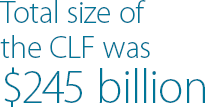
Over 2015/16, holdings of domestic assets increased by around $2 billion. The domestic assets are either purchased outright or held under repo.
Most of the Reserve Bank's transactions in the domestic market are contracted as repos as part of regular open market operations. A reverse repo involves an agreement to buy and then later sell securities; this is economically similar to a secured loan, with the difference between the purchase and sale prices representing the interest earned on the transaction. To protect against a decline in the value of the collateral securities should the Bank's counterparty not be able to meet its repurchase obligation, the Bank requires the value of the security to exceed the cash lent by a certain margin. These margins, which are listed on the Bank's website, are considerably higher for securities that are not issued by governments.[6]
| June 2014 | June 2015 | June 2016 | ||||
|---|---|---|---|---|---|---|
| $ billion | Per cent of total | $ billion | Per cent of total | $ billion | Per cent of total | |
| AGS | 17.6 | 25 | 21.3 | 28 | 29.2 | 33 |
| Semis | 15.5 | 22 | 9.8 | 13 | 6.7 | 8 |
| Supranational | 3.3 | 5 | 3.8 | 5 | 3.5 | 4 |
| Government guaranteed | 0.0 | 0 | 0.0 | 0 | 0.0 | 0 |
| ADI issued | 8.8 | 12 | 15.9 | 21 | 16.6 | 19 |
| Asset-backed securities | 25.1 | 35 | 25.3 | 33 | 31.7 | 36 |
| Of which for open repo | 24.3 | 34 | 24.1 | 32 | 27.2 | 31 |
| Other | 0.6 | 1 | 0.0 | 0 | 0.0 | 0 |
| Total | 70.9 | 100 | 76.2 | 100 | 87.7 | 100 |
| Of which for open repo | 25.2 | 36 | 25.6 | 34 | 29.3 | 33 |
|
(a) Market value of securities before the application of margins Source: RBA |
||||||
The size of the Reserve Bank's repo book ranged between $40 billion and $60 billion over the past financial year. With the stock of repos outstanding in the whole domestic market around $120 billion, the Bank's operations are a significant portion of the market, particularly for repos for longer terms. Participants in the Bank's market operations tend to be the fixed-income trading desks of banks and securities firms seeking to finance their inventories of AGS and semis, as well as bank treasuries. Reflecting this, over half of the securities held by the Bank (excluding those under open repo) are government-related obligations, with the remainder being bank-issued debt securities and residential mortgage-backed securities (RMBS). The average residual maturity of reverse repos contracted via open market operations in 2015/16 remained around one month.
Securities that are eligible in the Reserve Bank's open market operations are also eligible for open repo positions. Open repos are provided under the Reserve Bank's standing facilities for banks that have to settle payment obligations outside normal business hours, such as ‘direct-entry’ payments. As at the end of June 2016, 15 banks had open repo positions with the Reserve Bank, representing around $23 billion. To collateralise these open repos, the Bank has permitted the use of certain related-party assets issued by bankruptcy remote vehicles, such as self-securitised RMBS. Around 90 per cent of the outstanding amount of open repos is backed by these self-securitised assets. Self-securitised RMBS used in open repos do not have directly observable market prices, as they are retained in full by the bankruptcy remote trusts of originating institutions and are therefore not traded. As a result, the Bank uses an externally reviewed internal valuation model for self-securitised RMBS based on observed market prices of similarly structured RMBS.
Asset-backed securities form a significant share of the collateral securities the Reserve Bank purchases under open repo and they would be the major asset – particularly self-securitised RMBS – provided as collateral for the CLF. Given this, the Bank introduced mandatory reporting requirements for securitisations to remain eligible for use in its operations, which took effect on 30 June 2015. In 2015/16, the Bank received around 3,250 monthly data submissions on around 300 asset-backed transactions from issuers or their appointed information providers. For eligible RMBS, this covers around two million underlying individual housing loans with a balance of around $400 billion, which is over a quarter of the total value of housing loans. The required data include key information on the structure of the RMBS and the relationships that counterparties have within the RMBS structure; the required data also include information on the residential mortgage loans and the underlying collateral backing the RMBS structure.
Reflecting the Reserve Bank's interest in promoting increased transparency for investors in asset-backed securities, issuers are also required to make the information available to investors and other permitted users. The data provided to these users are broadly similar to the data provided to the Bank; however, issuers may redact some particular fields where the information poses a potential risk to privacy and provide aggregated data instead.
The mandatory reporting requirements allow the Reserve Bank (and potentially other investors in RMBS) to undertake a richer analysis of underlying risks in asset-backed securities and to price and manage risk for such securities more accurately.[7]
Domestic securities purchased by the Reserve Bank are held for safe custody in an account that the Bank maintains in Austraclear, the securities depository of the Australian Securities Exchange (ASX). Securities transactions conducted between the Bank and its counterparties are settled in the Austraclear system, mostly on a bilateral basis. The Bank also settles repo transactions contracted in its open market operations within ASX Collateral, a collateral management service. During the past financial year, between 5 and 15 per cent of the total amount of securities the Bank purchased under repo was settled within ASX Collateral.
The Reserve Bank continues to operate a Securities Lending Facility on behalf of the Australian Office of Financial Management (AOFM). The securities available through the facility comprise all Treasury Bonds and Treasury Indexed Bonds currently on issue. The Bank sells these securities either for intraday or overnight repurchase agreements to RITS members eligible to participate in the Bank's domestic market operations.
In addition to the securities held under repo, the Reserve Bank holds a smaller amount of both AGS and semis on an outright basis in its domestic portfolio. These are used for the Bank's management of system liquidity and are also available to be sold as collateral for repos.
An important influence on the composition of the Reserve Bank's holdings of AGS is the management of the impact of large AGS maturities on system liquidity. This reflects the Bank's need to mitigate the liquidity impact of the large volume of funds that are paid out of the Australian Government's account at the Bank into ESAs (for the credit of the security holder) on the maturity date. In addition to using reverse repos and foreign exchange swaps – both contracted to unwind and therefore withdraw liquidity on the same day as the AGS maturity – the Bank makes purchases of AGS ahead of their maturity date. Reflecting these operations, the Bank's holdings of AGS are concentrated in those issues with a short term to maturity, with these holdings increasing ahead of their maturity date. On occasion, the securities may be sold to the AOFM ahead of their maturity date.
Over the course of 2015/16, the Reserve Bank offset the liquidity effects of two large AGS maturities – the $13.9 billion maturity of the October 2015 bond and the $21.9 billion maturity of the June 2016 bond. To do this, the Bank purchased $6.9 billion of the October 2015 bond and $11.6 billion of the June 2016 bond prior to their maturity. In preparation for the large AGS maturities scheduled for 2016/17, the Bank had purchased $9.3 billion of the February 2017 bond (all of which was sold back to the AOFM) and $2.5 billion of the July 2017 bond by the end of 2015/16. The Bank's outright holdings of AGS are published monthly on the Bank's website.[8]
At the end of the financial year, the Reserve Bank held around $2.5 billion of semis on an outright basis. These securities are generally purchased as part of the Bank's daily open market operations or separately through outright purchase operations. The latter, which are conducted over the Yieldbroker DEBTS trading platform, occurred four times in 2015/16.
Foreign Exchange Operations
The Reserve Bank transacts in the foreign exchange market on almost all business days. The majority of these transactions are associated with providing foreign exchange services to its clients, the most significant of which is the Australian Government. During 2015/16, the Bank sold $10 billion of foreign currency to the government (not including sales related to International Monetary Fund (IMF) financing).
The Reserve Bank sources foreign currency for its customers through purchases in the spot market, only deviating from this strategy during periods where the market for Australian dollars is under significant strain. At those times, the Bank may use its existing stock of foreign currency reserves to fund its customer business, subsequently replenishing those reserves when market conditions have stabilised. Using foreign currency reserves in this manner has not been considered necessary since 2008, when global financial markets were significantly impaired. Similarly, the Bank has not ‘intervened’ in the foreign exchange market since 2008. Over the past year, the Bank's assessment was that trading conditions in the market were sufficiently orderly such that it was not necessary for the Bank to support liquidity in the market through its own transactions. The Bank nevertheless retains the discretion to intervene in the market for Australian dollars to address any apparent dysfunction and/or a significant misalignment in the value of the currency. Intervention data are published, with a lag, on the Bank's website.
The Reserve Bank also transacts in the foreign exchange market when managing its foreign currency reserves. As discussed below, the relative weightings of foreign currencies in the Bank's portfolio are managed against a benchmark. To maintain the portfolio at these benchmark weights, or to accommodate discrete changes in the weights, the Bank will transact in spot foreign exchange. The final settlement of these rebalancing flows may be deferred through the use of foreign exchange swaps, whereby one currency is exchanged for another, with a commitment to unwind the exchange at a subsequent date at an agreed (forward) rate. Swaps can also be an efficient way to manage the shorter-term investments included within the reserves portfolio. During 2015/16, swaps transacted for these purposes totalled around $83 billion.
As mentioned above, the Reserve Bank also makes use of foreign exchange swaps in its domestic market operations. Swapping Australian dollars for foreign currencies does not affect the exchange rate, but alters the supply of ES balances in the same way as the Bank's repurchase transactions. As there is limited depth in the domestic repo market, the Bank is better able to manage the impact of large projected changes in ES balances (such as those associated with government bond maturities) by using swaps as a complement to repurchase transactions. In 2015/16, $81 billion of foreign exchange swaps were undertaken for domestic liquidity management.
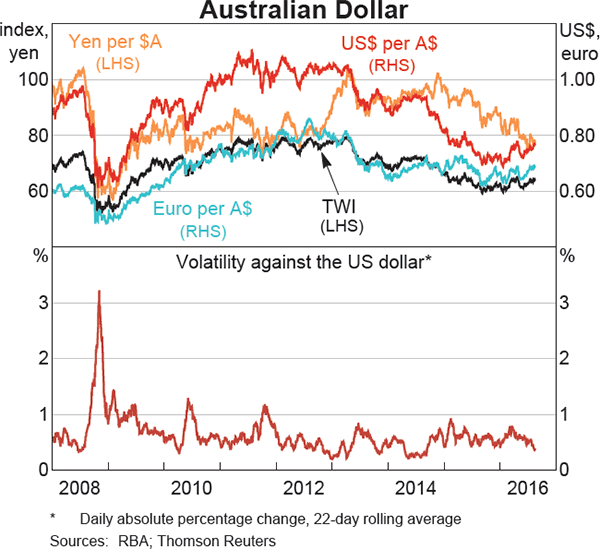
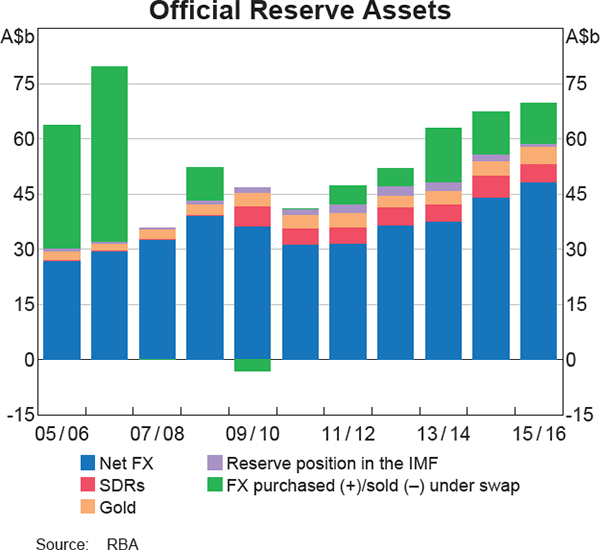
Foreign currency swaps executed by the Reserve Bank are generally for no more than three months' duration. The resulting forward foreign exchange positions with each of the Bank's counterparties are revalued daily and collateral is held against positions with net positive value. The terms under which collateral is exchanged are defined in two-way credit support annexes to the International Swaps and Derivatives Association (ISDA) Master Agreements, which the Bank has executed with each of its counterparties (see the chapter on ‘Risk Management’).
During the past year, the Reserve Bank applied for and was granted membership of the Chinese Interbank FX Market by the Chinese Foreign Exchange Trade System (CFETS). As a result, the Bank will be eligible to transact in the onshore market for Chinese renminbi with commercial counterparties. Previously, the Bank's foreign exchange transactions involving onshore renminbi were restricted to being with the People's Bank of China, the Chinese central bank.
Reserves Management
Australia's official reserve assets include foreign currency assets, gold, Special Drawing Rights (SDRs – a liability of the IMF) and Australia's reserve position in the IMF. Reserve assets are held primarily to facilitate the policy operations in the foreign exchange market described above. The Reserve Bank's capacity to undertake such operations is best measured by ‘net’ reserve assets, with the amount of foreign currency subject to forward commitments (such as foreign currency that the Bank has obtained from short-term swaps against Australian dollars) excluded. As at 30 June 2016, Australia's net reserve assets totalled $58.8 billion, an increase of $2.9 billion since 30 June 2015, which largely reflects valuation effects.
Australia's reserve position in the IMF is an asset of the Australian Government. All other components of Australia's official reserve assets are held on the Reserve Bank's balance sheet and the Bank is responsible for managing the level and composition of those reserves. As these assets can expose the Bank to various risks, including market, liquidity and credit risk (see the chapter on ‘Risk Management’ for more detail), the level held represents the amount assessed as necessary to meet potential policy requirements. Within that, the Bank seeks to mitigate risks where possible, such as by holding a diversified portfolio of assets and investing in assets of high credit quality and appropriate liquidity only.
| US dollar | Euro | Japanese yen | Canadian dollar | Chinese renminbi | UK pound sterling | South Korean won | |
|---|---|---|---|---|---|---|---|
| Currency allocation (per cent of total) | 55 | 20 | 5 | 5 | 5 | 5 | 5 |
| Duration (months) | 6 | 6 | 6 | 6 | 30 | 3 | 18 |
|
Source: RBA |
|||||||
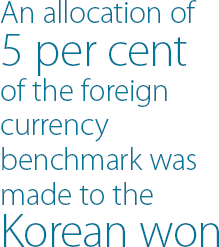
The composition of the Reserve Bank's foreign currency asset portfolio is guided by an internally constructed benchmark. This benchmark is assessed to be the combination of foreign currencies and foreign currency assets that will maximise the Bank's expected returns over the long run, subject to the Bank's risk tolerance. The structure of the benchmark is periodically reviewed to take account of significant changes in market conditions.
During 2015/16, an allocation of 5 per cent of the benchmark was made to the Korean won, which further diversified the portfolio and is expected to enhance returns over the long run. Offsetting this was a reduction in the allocation to euro from 25 per cent to 20 per cent. The Korean won's share in the benchmark portfolio is in line with the shares for the Japanese yen, Canadian dollar, UK pound sterling and Chinese renminbi. The allocation to the US dollar was unchanged at 55 per cent, with the large weight partly reflecting the greater liquidity of that currency market.
| Currency | Securities held outright | Securities held under reverse repurchase agreements | Deposits at official institutions(b) | Total | Forward FX commitments(c) | Net | |
|---|---|---|---|---|---|---|---|
| Against AUD | Against other currencies | ||||||
| US dollar | 12,370 | 988 | 787 | 14,145 | −538 | 12,841 | 26,448 |
| Euro | 3,903 | – | 28 | 3,931 | −1 | 5,668 | 9,598 |
| Japanese yen | 26,460 | 393 | 7,211 | 34,064 | −8,896 | −22,838 | 2,330 |
| Canadian dollar | 1,417 | – | 8 | 1,425 | – | 975 | 2,400 |
| Chinese renminbi | 2,289 | – | 1 | 2,290 | – | – | 2,290 |
| Pound sterling | 310 | – | – | 310 | – | 1,897 | 2,207 |
| South Korean won | 2,465 | – | 37 | 2,502 | – | – | 2,502 |
| Total | 49,214 | 1,381 | 8,072 | 58,667 | −9,435 | −1,456 | 47,775 |
|
(a) Excludes investments in the Asian bond funds Source: RBA |
|||||||
Reflecting the generally low level of global interest rates, duration targets have remained short for most of the foreign currency portfolios. Short duration targets mitigate the risk of capital losses should yields on bonds in these currencies return to more normal levels.
Investments in the benchmark currencies are limited to deposits at official institutions (such as central banks) and debt instruments issued or guaranteed by sovereigns, central banks, supranational agencies and (under reverse repurchase agreement only) quasi sovereigns. Sovereign credit exposures are currently limited to the United States, Germany, France, the Netherlands, Canada, Japan, China, the United Kingdom and South Korea.
At the end of June 2016, the Reserve Bank's foreign currency reserves included $9.4 billion of foreign currency sourced from swaps against Australian dollars. Foreign currency obtained in this manner does not comprise part of the benchmark portfolio, but is invested to ensure that the Bank's forward commitments to sell foreign currency are hedged against currency and interest rate risk.
As has been the case for some years, when the costs of hedging currency risk are taken into account, yields on short-dated Japanese investments have generally exceeded those available in the other currencies in the Reserve Bank's portfolio. Reflecting this, the bulk of the foreign currency the Bank obtains from swaps against Australian dollars is Japanese yen. For the same reason, the Bank also swaps other currencies in its reserves portfolio against the yen to enhance returns. As a consequence, while the Bank's exposure to changes in the value of the yen remains small (consistent with the yen's 5 per cent allocation in the Bank's benchmark), around 58 per cent of the Bank's foreign exchange reserves were invested in yen-denominated assets at the end of June 2016.
A small component of the Reserve Bank's net foreign currency reserves sits outside the benchmark framework. This encompasses investments in a number of Asian debt markets through participation in the Executives' Meeting of East Asia and Pacific Central Banks (EMEAP) Asian Bond Fund Initiative. This initiative was established in the wake of the Asian currency crisis in the late 1990s to assist in the development of bond markets in the region. At the end of June 2016, the total allocation of the Bank's reserves to these funds was $621 million and the return on these investments in 2015/16 was 3.4 per cent when measured in SDR terms. On 1 July 2016, following agreement among member central banks that the US dollar denominated fund (ABF1) had served its original purpose, EMEAP announced the closure of this fund.[9] The funds of member central banks (including the Reserve Bank) in ABF1 were transferred to Asian Bond Fund 2 (ABF2), which invests in local currency-denominated securities.
Measured in SDRs, the overall return on the Reserve Bank's foreign currency assets over 2015/16 was 1.9 per cent, lower than the previous year but broadly in line with the period between 2010/11 and 2013/14. This outcome reflected small contributions from interest income and capital gains on bond holdings, as well as exchange rate valuation effects. The running yield on the benchmark portfolio remained very low at around 0.3 per cent, reflecting low or negative bond yields across a number of the major economies.
The Reserve Bank's holdings of SDRs at 30 June 2016 amounted to $4.9 billion, $1.0 billion lower than the previous year, as net sales of SDRs over the year more than offset the impact of the depreciation of the Australian dollar against the SDR. Under voluntary arrangements with the IMF, the Bank is willing to transact in SDRs upon request from other countries or prescribed holders. In these transactions, the Bank will generally either buy or sell SDRs in exchange for foreign currencies (such as euros or US dollars). While such transactions do not alter the level of Australia's reserve assets (only the respective proportions held in SDRs and foreign currency), the Bank occasionally chooses to replenish foreign currency sold in exchange for SDRs by purchasing additional foreign currency against Australian dollars in the spot market.
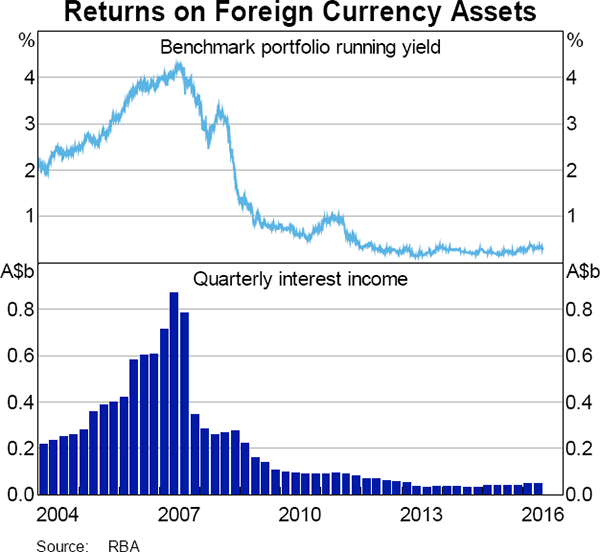
Australia's reserve position in the IMF comprises that part of Australia's quota in the IMF that is paid in foreign currency as well as other credit that Australia has extended to the IMF in support of its lending programs. At the end of June 2016, Australia's reserve position in the IMF was $867 million (SDR461 million), which is $937 million (SDR526 million) lower than the previous year and its lowest level since 2009. The decline in the reserve position in the past year was due almost entirely to flows associated with the implementation of the IMF's 14th General Review of Quotas in early 2016 (see the ‘International Financial Cooperation’ chapter for more detail). Specifically, in order to give effect to the increase in the IMF's quota resources, the Australian Government paid US$1,165 million (SDR834 million) in foreign currency to the IMF, which increased Australia's reserve position. This foreign currency payment was subsequently more than offset by the receipt of a US$1,876 million (SDR1,340 million) currency reallocation flow from the IMF, which reduced Australia's reserve position. The currency reallocation flow was the result of a process undertaken by the IMF to redistribute the foreign currency quota payments received from other IMF members (predominantly in US dollars) across the currencies of a much broader of list of 51 IMF creditor countries, including Australia.
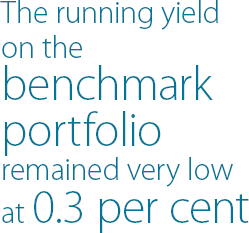
As noted above, Australia's reserve position in the IMF is not held on the Reserve Bank's balance sheet. However, the Bank will sell to (or purchase from) the Australian Treasury the foreign currency the Treasury needs to complete its transactions with the IMF. In contrast to other foreign exchange transactions with the Australian Government, the Bank will typically draw on (or add to) its foreign currency reserves when providing (or receiving) foreign currency for IMF-related purposes. This is because any change to the Bank's holdings of foreign currency assets will be offset by an equivalent change in Australia's reserve position in the IMF, leaving total official reserve assets unchanged. Nevertheless, as with SDR transactions, on certain occasions the Bank may decide to offset the impact on foreign currency asset holdings of these IMF transactions by buying or selling foreign currency in exchange for Australian dollars in the spot market. In the case of the IMF quota transactions in 2015/16 described above, the net increase in the Bank's foreign currency reserves was offset by an equivalent reduction in Australia's reserve position in the IMF, leaving total official reserve assets unchanged.
Gold holdings at the end of June 2016 were around 80 tonnes, unchanged from the previous year. Gold prices rose by 17 per cent in Australian dollar terms in 2015/16, increasing the value of the Reserve Bank's holdings of gold by around $0.65 billion to $4.6 billion. At $0.45 million, income from gold loans was slightly higher than in recent years, as the Bank increased its lending activity.
Bilateral Currency Swaps
In December 2015, the Reserve Bank signed a bilateral local currency swap agreement with Bank Indonesia. The agreement allows for the exchange of local currencies between the two central banks of up to A$10 billion or IDR 100 trillion. In March 2016, the Reserve Bank signed a bilateral local currency swap agreement with the Bank of Japan. This agreement allows for the exchange of local currencies between the two central banks of up to A$20 billion or JPY 1.6 trillion. The period of each of these agreements is three years and could be extended by mutual consent. The Reserve Bank has similar agreements with the People's Bank of China and the Bank of Korea. The purpose of these agreements is to allow each central bank to support trade settlement in local currencies, particularly in times of market stress, or to support financial stability.
Footnotes
See International Organization of Securities Commissions (2013), Principles for Financial Benchmarks, Final Report, July. Available at <https://www.iosco.org/library/pubdocs/pdf/IOSCOPD415.pdf>. [1]
See <http://www.rba.gov.au/mkt-operations/resources/cash-rate-methodology/cash-rate-procedures-manual.html>. [2]
See <http://www.rba.gov.au/mkt-operations/resources/cash-rate-methodology/compliance.html>. [3]
See Financial Stability Board (2014), ‘Reforming Major Interest Rate Benchmarks’, July. Available at <http://www.financialstabilityboard.org/wp-content/uploads/r_140722.pdf>. [4]
The CLF legal documentation is available at <http://www.rba.gov.au/mkt-operations/resources/tech-notes/pdf/clf-terms-and-conditions.pdf> and <http://www.rba.gov.au/mkt-operations/resources/tech-notes/clf-operational-notes.html>. [5]
See <http://www.rba.gov.au/mkt-operations/resources/tech-notes/eligible-securities.html>. [6]
Some preliminary analysis of the securitisations data was included in a speech by Guy Debelle, Assistant Governor (Financial Markets), in December 2015. See <http://www.rba.gov.au/speeches/2015/sp-ag-2015-12-16.html>. [7]
See <http://www.rba.gov.au/mkt-operations/dom-mkt-oper.html>. [8]
For more detail, see <http://www.emeap.org/wp-content/uploads/2016/06/EMEAP_Asian_Bond_Fund_-_1_July_2016-1.pdf>. [9]